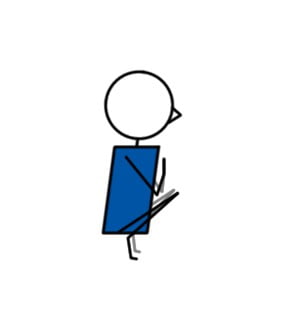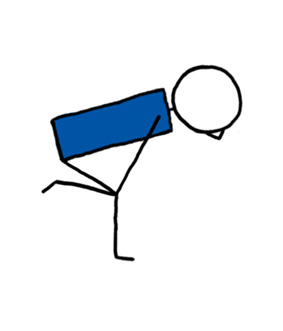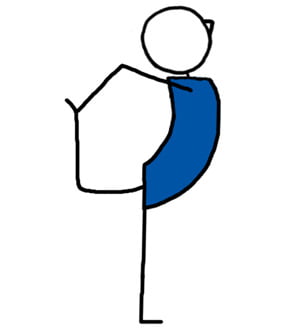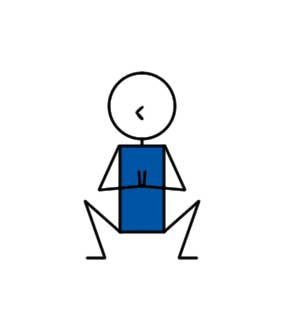
| Category: | Yoga Lesson Planner |
|---|---|
| Sub Category: | Standing |
| Types: | Balance, Hip Opener, Standing |
| Anatomy: | Arms & Shoulders, Hamstrings, Hips, Knees, Psoas, Wrists & Arms |
| Chakras: | Base, Heart Centre, Sacral Centre, Solar Plexus Centre |
| Therapy: | Back Pain, Poor Posture |
| Drishti: | Tip Of Nose |
| Dosha: | Kapha, Pitta |
| Meridian Lines: | Stomach |
Stand upright with your back straight. Feet close together (or touching). Squat on toes.
Strengthens toes, feet, thighs, buttocks, and hamstrings.
A) Sit on the front edge of a chair. B) Folded blanket under heels. C) Lift all ten toes up. D) Bring arms to tops of legs and reach outward. E) Sit back against a wall like you are in a chair. F) Add a twist. G) Sit on a block. H) Roll a blanket and place it in the crease of both knees.
Knee injury.
Click here for lots of FREE downloadable Yoga lesson plans.
Click here for lots of FREE downloadable Pilates lesson plans.
- 60 minute power yoga
- Sefira yoga Tiferet
- Cavendish 30 Apr 19
- 60 minute power yoga WLC 20 March 2018
- Flow with back bends 06-03-18
- Cavendish 23 Apr 19
- Beginner Yoga:October 2017
- Strap Yoga
- Element Fire - part two
- 60 minute power yoga
- Strap Yoga
- Ask Genie1
- INHALE YOGA with Maria Josefina Barrio
- 60 minute power yoga
- Balance
- Twist Core Combo
- Hot Yoga OM - Fallen Angel
- 2017 Week 47
- Yoga for Vaulters
- 15 Minute Yoga: 136 Standing Poses
- Yoga for Inner Legs
- Hot Yoga OM - Fallen Angel
- Twist Core Combo
- Vinyasa warriors humming warrior 2
- Ask Genie1
- Vinyasa warriors humming warrior 2
- Morning Balance Feb 11 2018
- Inversions 12 and 13 Feb
- Morning Balance Feb 16
- Ask Genie3
- Twist Core Combo 1
- Flow with back bends 06-03-18
- Flow Gentle 12-03-18
- Standing - copy
- The 3rd Eye Chakra with Adrienne
- Chair to Skater
- Journey to Headstand
- Hot Yoga OM - Fallen Ange1
- solar plexus chakra, 1
- solar plexus chakra, 2
- Flow and Align 2
- solar plexus chakra, 3
- Flow and Align 2
- solar plexus chakra, 4
- 'May Day' Lesson Plan
- Standing II
- Ask Genie2
- Release 29-05-18
- Hot Yoga OM - Fallen Angel
- Yin pause and restore
- Seasonal yoga late summer flow
- 22 August 2018
- 60 minute power yoga WLC 4 September 2018
- Fire sep 2018
- Ask Genie2
- flow and align 5
- 18 September Starfish Warrior
- sam
- Slow flow for Office Junkies
- 2018 week 40
- 2018 week 40-2
- Hot Yoga OM - Fallen Angel
- RLS Week 1: Locust Peak Pose
- focus lower back and shoulders
- Element Fire Workshop
- Journey to Headstand
- Yoga For Cyclists: 41 Post Ride Sequences
- Element Fire Workshop
- Beginner Yoga: March 2019
- Cavendish 2 Apr 19
- Cavendish 7 May 19
- Cavendish 14 May 19
- Cavendish 21 May 19
- Standing
- Cavendish 4 June 19
- 3.6 Tuesday 4.6.19
- Beginers Hatha Yoga week 1
- Cavendish 11 June 19
- Cavendish 18 June 19
- Cavendish 18 June 19
- Ask Genie5
- Beginers Hatha Yoga week 1
- Cavendish 25 June 19
- Thursday Relaxation Evening Chakras
- standing
- Cavendish 2 Jul 19
- Cavendish 9 Jul 19
- Friday 9.1Pat 1.37
- 2019 Week 31
- A gentle time
- Pitta Cooling
- Short yoga sequance for abdominal strength
- Tuesday 4.6
- Letting go of Summer
- Letting go of Summer
- Cavendish 3 Sep 19
- Letting go of Summer 2019
- Cavendish 10 Sep 19
- Cavendish 17 Sep 19
- Cavendish 29 Oct 19
Squat Pose FAQs
What is the Sanskrit of Squat Pose?
Malasana
You can get your students to remember the pose (when teaching a class) by turning “Malasana” into a mantra (if, for example, it’s the peak pose in your yoga lesson plan). During the rest postures (e.g. Child Pose, Extended Child Pose) or when they are performing Squat Pose, ask your students to repeat the word “Malasana” multiple times as a mantra.
What are other names for Squat Pose?
- Deep squat pose
- Garland pose
- Sitting down pose
- Upavesasana
What’s the most important thing to be aware of in a Squat pose?
Make sure that the knees are pointing in the same direction as your toes.
What should I be aware of when in a Squat pose?
Squat pose challenges will challenge your entire body because it requires mobility and stability in the ankles, knees, hips, pelvis, and spine.
When in the pose silently ask yourself these questions:
- How does it feel?
- Where do I feel it?
- Are my heels lifted (the goal is to have the heels down)?
- Are my ankles rolling in?
- Are my arches collapsed?
- Are my toes turning out excessively (or do they want to)?
- How do my knees look and feel?
- Are my knees collapsing in?
- Is one knee collapsing in more than the other?
- Is one hip closer to the ground?
- Am I leaning to one side?
- Is my spine straight, arched, or rounding forward?
- Is my tailbone tucking under excessively?
If my heels are lifted when in a Squat pose what does that mean?
If your heels are lifted, it usually indicates a limitation in the Achilles tendon and calves. Allow your heels to lift and over time, with regular practice, the heels will lower down to the floor. It may also indicate hamstring tightness, piriformis tightness, or weakness in the gluteus medius. An easy way to make the pose more accessible is to place a rolled-up towel or blanket under the heels for support. If your heels are close to the ground, try widening your feet and turning the toes out.
How wide should my stance be in a Squat pose?
Have fun experimenting with a wide and narrow stance to find the ideal Squat pose width for you. There is no one-size-fits-all.
If my heels are knees collapsed when in a Squat pose what does that mean?
If your knees are collapsed (hips are internally rotated), you may have weak gluteus muscles, tight adductors (inner thighs), or a tight iliotibial band (a band of fascia along the outside of the leg from the hip to the knee).
If my low back is arched excessively when in a Squat pose what does that mean?
If your low back arched excessively, you may have tight hip flexors that are compensating for weak core muscles.
If my spine is rounded forward when in a Squat pose what does that mean?
If your spine is rounded forward, you may have weak erector spinae muscles (iliocostalis, longissimus, and spinalis), a tight thoracic (middle) spine, or tight hamstrings.
If I lean to one side when in a Squat pose what does that mean?
Leaning to one side could mean that you have a stability problem or an asymmetry (two sides that are not the same) of the ankle, knee, or hip.
If one shoulder is higher than the other in a Squat pose what does that mean?
It’s common for the shoulder of our dominant side to be tighter, and less mobile.
What are some modifications to the Squat pose?
A) Sit on the front edge of a chair.
B) Folded blanket under heels.
C) Lift all ten toes up.
D) Bring arms to the tops of legs and reach outward.
E) Sit back against a wall like you are in a chair.
F) Add a twist.
G) Sit on a block.
H) Roll a blanket and place it in the crease of both knees.




 Yoga Lesson Planner
Yoga Lesson Planner
 Pilates Lesson Planner
Pilates Lesson Planner











